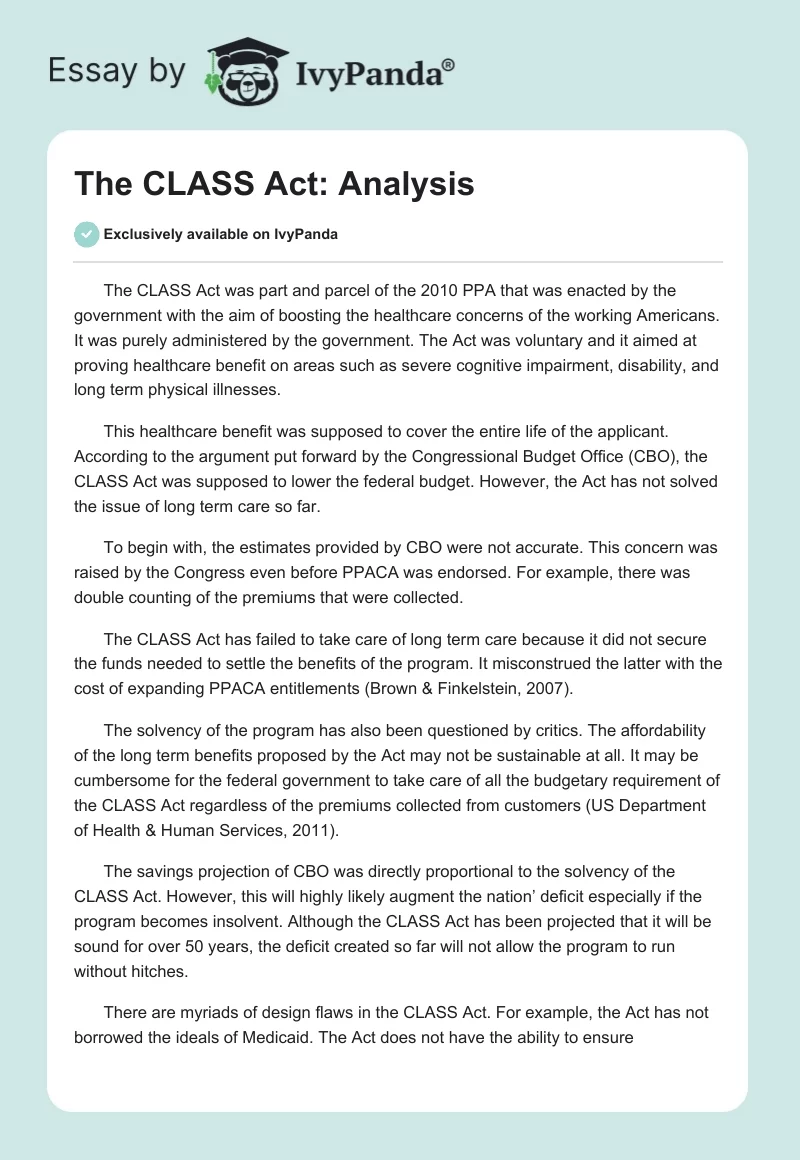The CLASS Act was part and parcel of the 2010 PPA that was enacted by the government with the aim of boosting the healthcare concerns of the working Americans. It was purely administered by the government. The Act was voluntary and it aimed at proving healthcare benefit on areas such as severe cognitive impairment, disability, and long term physical illnesses.
This healthcare benefit was supposed to cover the entire life of the applicant. According to the argument put forward by the Congressional Budget Office (CBO), the CLASS Act was supposed to lower the federal budget. However, the Act has not solved the issue of long term care so far.
To begin with, the estimates provided by CBO were not accurate. This concern was raised by the Congress even before PPACA was endorsed. For example, there was double counting of the premiums that were collected.
The CLASS Act has failed to take care of long term care because it did not secure the funds needed to settle the benefits of the program. It misconstrued the latter with the cost of expanding PPACA entitlements (Brown & Finkelstein, 2007).
The solvency of the program has also been questioned by critics. The affordability of the long term benefits proposed by the Act may not be sustainable at all. It may be cumbersome for the federal government to take care of all the budgetary requirement of the CLASS Act regardless of the premiums collected from customers (US Department of Health & Human Services, 2011).
The savings projection of CBO was directly proportional to the solvency of the CLASS Act. However, this will highly likely augment the nation’ deficit especially if the program becomes insolvent. Although the CLASS Act has been projected that it will be sound for over 50 years, the deficit created so far will not allow the program to run without hitches.
There are myriads of design flaws in the CLASS Act. For example, the Act has not borrowed the ideals of Medicaid. The Act does not have the ability to ensure uninterrupted enrolment or even lowering the rate of underwriting by insurance companies.
The private insurance plans seem to be doing better than the CLASS Act. Moreover, it is not practical for the Act to maintain the solvency for over seven decades. There are also myriads of legislative revisions that have been carried out on the CLASS Act. Eventually, its contents have been made weak (Nyman, 1988).
The Appropriations Committee drawn from the Senate also hampered the operations of the CLASS Act when it withdrew over $100 million that was meant to market and redesign the program.
This clearly shows that long term care can hardly be catered for by the program since it has no political goodwill even at the Senate level (Nyman & Connor, 1994). Perhaps, the CLASS Act would have catered for the long term care if the concerns of the Congress would have been put into consideration. However, the implementation level of the program failed against the expectations.
According to Pareto efficiency, it is vital to create a balance between the utility of users and the revenue of carriers. In other words, the two aspects should be maximized. In the case of the CLASS Act, it was supposed to benefit the working Americans.
On the same note, it was expected to lower the budgetary deficit of the federal government. However, both the revenue carrier and the user have not benefited from this program. Therefore, the greatest losers are the Americans who had enrolled for the program and the federal government. None of them gained from the program.
References
Brown, R.F. & Finkelstein, A. (2007). Why is the market for long-term care insurance so small? Journal of Public Economics 91, 1967–1991.
Nyman, A.J. & Connor, A.R. (1994). Do case-mix adjusted nursing home reimbursements actually reflect costs? Minnesota’s experience. Journal of Health Economics. 13, 145-162.
Nyman, A.J. (1988). The marginal cost of nursing home care. Journal of Health Economics 7, 393-412.
US Department of Health & Human Services (2011). Secretary Sebelius’ Letter to Congress about CLASS. Web.


